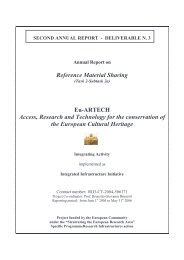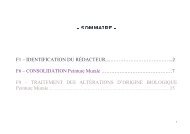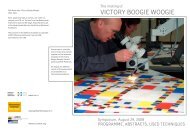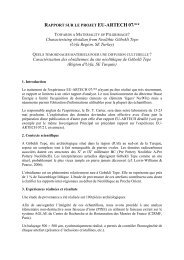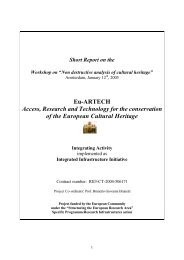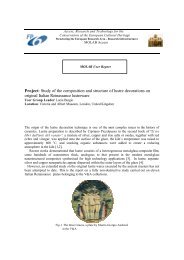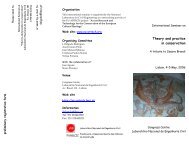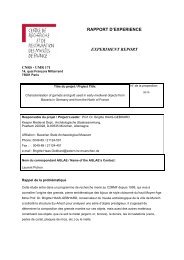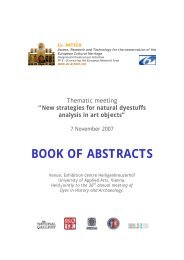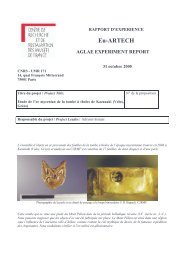N1 CERC3 Workshop - Eu-ARTECH
N1 CERC3 Workshop - Eu-ARTECH
N1 CERC3 Workshop - Eu-ARTECH
You also want an ePaper? Increase the reach of your titles
YUMPU automatically turns print PDFs into web optimized ePapers that Google loves.
SECOND ANNUAL REPORT – DELIVERABLE N. 7<br />
Short Report<br />
CERC 3 Young Chemists’ <strong>Workshop</strong><br />
Chemistry for the Conservation of Cultural Heritage: Present and<br />
Future Perspectives<br />
Perugia, Italy, March 19 th -22 nd , 2006<br />
supported by<br />
<strong>Eu</strong>-<strong>ARTECH</strong><br />
Access, Research and Technology for the<br />
conservation of the <strong>Eu</strong>ropean Cultural Heritage<br />
Integrating Activity<br />
implemented as<br />
Integrated Infrastructure Initiative<br />
Contract number: RII3-CT-2004-506171<br />
Project Co-ordinator: Prof. Brunetto Giovanni Brunetti<br />
Reporting period: from June 1 st 2005 to May 31 st 2006<br />
Project funded by the <strong>Eu</strong>ropean Community<br />
under the “Structuring the <strong>Eu</strong>ropean Research Area”<br />
Specific Programme Research Infrastructures Action
The <strong>CERC3</strong> Young Chemists' <strong>Workshop</strong> on the Chemistry applications to the field of<br />
Cultural Heritage took place at the end of March 2006 in Perugia (Italy), jointly organised by<br />
the Italian CNR and French CNRS.<br />
<strong>Eu</strong>-<strong>ARTECH</strong> supported the initiative.<br />
The Agenda:<br />
Sunday, March 19 th<br />
14.30 - 15.00 Antonio Sgamellotti (<strong>CERC3</strong> representative), Opening address<br />
15.00 - 15.30 Francis Secheresse (CNRS) and Sylvie Colinart (French Culture Ministry)<br />
TOPIC 1: Pigments (Chair: M. Regert)<br />
15.30 - 16.00 Sandrine Pages-Campagna (FR): Non or micro-destructive fine characterisation of blue<br />
pigments using a range of complementary elementary and structural analytical techniques.<br />
16.00 – 16.30 Maria João Seixas de Melo (PT): Photochemistry: a soft approach to the<br />
characterization of dyes and lakes in Cultural Heritage.<br />
16.30 – 17.00 Francesca Casadio (US): Plasmonic nanostructures for higly sensitive detection of<br />
traditional artists` red dyestuffs with surface enhanced Raman spectroscopy.<br />
17.00 – 17.30 Coffee break<br />
17.30 – 18.00 Marika Spring (UK): Insight into the chemistry of deteriorated smalt pigment through<br />
analysis of samples from National Gallery paintings.<br />
18.00 – 18.30 Katrine Keune (NL): How red old master paint transforms into black and white.<br />
Monday, March 20 th<br />
TOPIC 2: Organic matter (Chair: L. Cartechini)<br />
9.30 – 10.00 Ineke Joosten (NL): Micro analysis on Hallstatt textiles: colour and condition<br />
10.00 – 10.30 Ilaria Bonaduce (IT): GC-MS and MS analytical procedures for the characterisation of<br />
lipids, waxes, resinous and proteinaceous materials in paint micro-samples and archaeological<br />
residues.<br />
10.30 – 11.00 Martine Regert (FR): Development of an analytical multi-step methodology for the<br />
characterisation of organic substances from our cultural heritage.<br />
11.00- 11.30 Coffee break<br />
11.30 –12.00 Jan Wouters (Invited speaker): The Conservation Committee of the International Council<br />
of Museums (ICOM-CC): why young scientists should get connected to this worldwide professional<br />
network.<br />
12.00 – 12.30 Catherine Higgitt (UK): Propolis (bee glue): an unusual mordant for gilding in Italian<br />
renaissance paintings.<br />
12.30 – 13.00 Agnès Lattuati-Derieux (FR): Development of a non-destructive SPME-GC/MS method<br />
for the characterisation of volatile organic compounds emitted by art objects in the cultural field with<br />
application to conservation materials, archaeological substances and graphic documents.<br />
13.00 – 14.30 Lunch<br />
TOPIC 4: Development of non-destructive techniques (Chair: S. Pages-Campagna)<br />
14.30 – 15.00 Costanza Miliani (IT): Using fiber optic FTIR spectroscopy from mid to near infrared to<br />
asses non-invasively the polychromy composition of easel paintings.<br />
15.00 – 15.30 Peter Vandenabeele (BE): Mobile Raman spectroscopy: a non-destructive tool for the<br />
investigation of objects of art.<br />
15.30 – 16.00 Ludovic Bellot-Gurlet (FR): Towards a non-destructive multi-step analytical<br />
methodology for the provenance determination of archaeological obsidian tools.<br />
16.00 – 16.30 Ina Reiche (FR): Micro-XRF goes 3D – Non-destructive investigations of Paint layers<br />
of Indian Miniatures.
16.30 – 17.00 Melena Calvo del Castillo (ES): Ionoluminescence & Gemstones: a non destructive<br />
characterization method.<br />
17.00 – 17.30 Coffee break<br />
TOPIC 5: Exploiting non-conventional techniques (Chair: F. Casadio)<br />
17.30 – 18.00 Laura Cartechini (IT): Non destructive study of ancient bronzes by neutron diffraction.<br />
18.00 – 18.30 Philippe Dillmann (FR): Iron artefact elaboration and degradation. Filling the gap<br />
between archaeological site and synchrotron ring.<br />
18.30 – 19.00 Edith Joseph (IT): FTIR micro spectroscopy applied to the analysis of painted surface.<br />
19.00 –19.30 Catherine M. Oertel (US): Focused-Ion Beam and Electron Microscopy Studies of<br />
Corrosion in Lead-Tin Alloy Organ Pipes.<br />
Tuesday, March 21 st<br />
TOPIC 3: New materials and methods for conservation (Chair: M. J. Seixas de Melo)<br />
9.30 – 10.00 Esther Rebollar (ES): Cleaning and microanalysis of artworks using lasers.<br />
10.00 – 10.30 Emiliano Carretti (IT): Nanotechnologies based cleaning systems: an innovative tool in<br />
cultural heritage conservation.<br />
10.30 – 11.00 Ilaria Nardini (IT): The stratigraphic study of stone surfaces and the proposal of a new<br />
concept of cleaning intervention.<br />
11.00 - 11.30 Coffee break<br />
11.30 –12.00 Barbara Dal Bianco (IT): Applications of Sol-Gel Silica for the study of ancient glass<br />
weathering.<br />
12.00 - 12.30 Claudia Altavilla (IT): Nanotechnology applied to glass surface protection.<br />
12.30 – 13.00 Maria Brunskog (SE): Japanning - polychromy and still not.<br />
13.00 – 14.30 Lunch<br />
16.00 – 18.30 Visit to the Galleria Nazionale dell`Umbria.<br />
20.30 Social Dinner at Hotel Gio`<br />
Wednesday, March 22 nd<br />
TOPIC 3: New materials and methods for conservation (Chair: C. Miliani)<br />
9.30 – 10.00 Charlotte Gjelstrup Björdal (SE): Waterlogged archaeological wood. Relating<br />
biochemical processes to degradation.<br />
10.00 – 10.30 Sandrine Morlat-Therias (FR): Durability of new polymers for consolidation of<br />
waterlogged woods.<br />
10.30 – 11.00 Patrick Dietemann (DE): Studying the aging of natural resin varnishes - Application of<br />
electron paramagnetic resonance spectroscopy and graphite-assisted laser desorption/ionization mass<br />
spectrometry to the problem.<br />
11.00 – 11.30 Coffee break<br />
11.30 – 12.00 Barbara Wagner (PL): Micro-spectrochemical investigation of historic manuscripts<br />
endangered by iron-gall ink corrosion.<br />
12.00 – 12.30 António José Estevão Grande Candeias (PT): Characterization of ancient mortars from<br />
different historical ages.<br />
12.30 – 13.00 Closing remarks.<br />
_________________________________________________<br />
Extended Abstracts are available on the <strong>Eu</strong>-<strong>ARTECH</strong> website (Events)<br />
__________________________________________________________
About 30 young chemists - coming from Italy (7), France (7), UK (2), Spain (2), Portugal (2), Sweden<br />
(2), Germany (1), USA (2), The Netherlands (2) and Belgium (1)- were selected and invited to present<br />
their research activity on the following main topics:<br />
1. pigments;<br />
2. organic matter;<br />
3. new materials and methods for conservation;<br />
4. development of non-destructive techniques;<br />
5. exploiting non-conventional techniques.<br />
All the presentations were of high scientific value. They were systematically followed by several<br />
questions of interest and discussions initiated after the communications were often going on during the<br />
breaks, highlighting the involvement of the participants.<br />
The number of participants (about 30) was ideal for fruitful scientific exchanges. Moreover, the<br />
meeting venue was the same hotel where people were accommodated so they could discuss not only<br />
during the work sections but also during lunches, dinners and social events.<br />
The introduction of the meeting by Prof. Antonio Sgamellotti from CNR & University of Perugia was<br />
of great relevance for presenting the <strong>CERC3</strong> activity and the history of the YCWs to participants. Prof.<br />
Francis Sécheresse from the CNRS and Dr. Sylvie Colinart from the French Ministry of Culture gave<br />
an overview of the French research activity on safeguard of Cultural Heritage. The invited conference<br />
from Dr. Jan Wouters from the KIK-IRPA about the ICOM-CC (International Council of Museums-<br />
Conservation Committee) was also appreciated since he provided interesting information on needs of<br />
the ICOM committees.<br />
The meeting was organised around the 5 topics listed above and a short summary of the developed<br />
discussions is provided in the following. The workshop program, the book of abstracts and the list of<br />
participants are also provided in attachment.<br />
Topic 1: Pigments - The first topic regarding the analysis of traditional pigments was discussed<br />
through five talks. First, it has been presented a review on the main issues concerning the<br />
identification of blue pigments ranging from the old synthetic Egyptian blue to the modern cobalt blue.<br />
Then two new analytical tools for the identification of organic lakes have been discussed, one based<br />
on the UV-vis fluorescence micro-spectroscopy and the other based on surface enhancement Raman<br />
effect (SERS). Finally, studies on the mechanism of bleaching of smalt and on that of blackening of<br />
cinnabar have been presented, based on SEM-EDS and SIMS microanalysis of several original<br />
alterated-painting layers.<br />
Topic 2: Organic matter - Five oral communications were presented in this session. All the<br />
presentations illustrated different aspects of the researches dedicated to the study of organic matter<br />
preserved in our cultural heritage. Dyes on textiles, waxy substances, proteinaceous materials,<br />
propolis, a substance produced by bees together with beeswax, were concerned.<br />
Most of the communications insisted on the analytical strategies that have to be developed for<br />
unravelling the complex molecular and elementary composition of organic substances, sometimes<br />
mixed with inorganic ones, in tiny samples made of complex altered molecular mixtures. Analytical<br />
methods based on the complementary use of infrared spectroscopy, mass spectrometry,<br />
chromatographic procedures, either by HPLC (high performance liquid chromatography) or GC (gas<br />
chromatography), potentially coupled with mass spectrometry, were described and the results obtained<br />
on dyes from archaeological Bronze Age and Hallstatt period textiles, on paintings, wax sculptures<br />
and archaeological residues were discussed.<br />
A method recently developed in the field of cultural heritage, SPME GC-MS (Solid Phase Micro-<br />
Extraction Gas Chromatography – Mass spectrometry), that allows to trap the volatile organic<br />
components emitted by various materials, was also emphasized.
Topic 3: New materials and methods for conservation - This topic was organised around eight oral<br />
presentations that may be divided into three main areas: cleaning methods, new ways of glass surface<br />
protection, alteration of various materials such as waterlogged woods or terpenoid resins. Interesting<br />
communications on cases of alteration of Japan polychromy and characterization of ancient mortars<br />
were also presented.<br />
One of the most innovative point was the presentation of new innovative reversible gels for the safe<br />
cleaning of easel paintings. The development of new polymers, issued from PEG on which<br />
antioxidants are grafted also open new perspective for a better preservation of the waterlogged woods<br />
on long periods of time.<br />
Concerning the development of new analytical tools for understanding the alteration of materials from<br />
our Cultural Heritage, the use of GALDI (Graphite Assisted Laser Desorption Ionisation) followed by<br />
mass spectrometry analysis was shown to be well adapted for following the oxidation processes to<br />
which terpenoid resins are exposed during ageing.<br />
Topic 4: Development of non-destructive techniques - Within this section five papers have been<br />
presented addressing the up-to-date research activity in that field. Two talks presented new portable<br />
equipments devoted to the study of easel and mural paintings: a portable microRaman and a portable<br />
mid-FTIR fiber-optic spectrometer. Of interest was also the 3D micro-XRF technique exploited for the<br />
non-invasive stratigraphical study of miniatures and the ion luminescence exploited for the noninvasive<br />
identification of gemstones. Finally, the PIXE and microRaman spectroscopies were<br />
discussed in a multi-step analytical methodology to study archaeological obsidians.<br />
Topic 5: Exploiting non-conventional techniques - Four talks have been adressed on this topic<br />
reporting the use of non-conventional techniques to the study of metals. It has been reported about<br />
neutron scattering as a powerful tool for studies of archaeological bronzes due to the high penetration<br />
capability of neutrons and their high sensitivity for structural details in the diffraction mode. The<br />
corrosion products of iron artefacts have been successfully characterized by µXRD and µX ray<br />
Absorption Near Edge Structure (µXANES) experiments on synchrotron beam-lines (ESRF, SLS).<br />
Finally, an interesting paper reported for the first time the use of Focused-Ion Beam and Electron<br />
Microscopy to study of the corrosion in tin-lead alloy organ pipes.<br />
CERC 3 YOUNG CHEMISTS’S WORKSHOP<br />
Perugia, March 19 th -22 nd 2006



